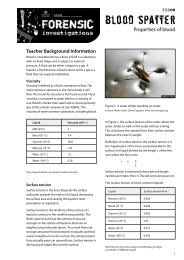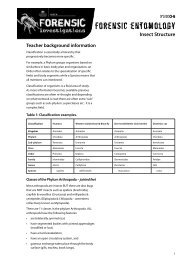FSE 10 Teachers activity [PDF File, 3.0 MB] - Centre for Learning ...
FSE 10 Teachers activity [PDF File, 3.0 MB] - Centre for Learning ...
FSE 10 Teachers activity [PDF File, 3.0 MB] - Centre for Learning ...
You also want an ePaper? Increase the reach of your titles
YUMPU automatically turns print PDFs into web optimized ePapers that Google loves.
<strong>FSE</strong><strong>10</strong><strong>for</strong>ensic entomology<strong>Teachers</strong>: Activity In<strong>for</strong>mationThe scene was clearly photographed and the time ofdata collection was recorded.When he returned to his office he contacted theclosest meteorological station to get a climatologicalreport of the weather of the preceding 2 weeks.AT THE LABORATORYNotes from the crime sceneDr Dadour made the following notes about the crimescene.• Most of the maggots were large 3rd instarmaggots.• No empty pupae cases were found.• There was only a small number of pupae found inrelation to the number of maggots.• The body was found in a damp, shady location.• There was a definite odour at the crime site.Processing the collected insectsDr Dadour did the following.• The larvae were visually identified as being 3rdinstar.• Approximately 1 dozen were killed in hotwater then transferred to 70% ethyl alcohol <strong>for</strong>microscopy studies – identification of species.• Approximately 1 dozen larvae were reared at 24 o C.• All collected pupae were reared at 24 o C.• All of the adult flies and some of the maggots werepreserved in 70% ethyl alcohol.The largest sized maggot found at the crime scenewas identified as a late third instar maggot Luciliasericata. Dr Dadour noted that this maggot was at late3 rd stage because the maggot had regurgitated theirgut. This happens just be<strong>for</strong>e pupation.The lower development threshold was considered tobe <strong>10</strong> o C <strong>for</strong> all species.On the 17 th of November, Dr Dadour collected the datafrom the weather station left at the crime scene andentered the maximum and minimum temperaturesinto Table 6. He then calculated a correction factor (cf)<strong>for</strong> the temperature data. Applying a correction factoris necessary as the temperature at the crime scenemay be significantly different from the meteorologicaldata that is available.Table 1: The day and time of adult fly emergencesfrom the pupae and larvae being reared in thelaboratory at 24 o C. Species identification frommicroscopy studies is also included.Emergence date Time Number SpeciesCollected as pupae19th November 7.30am <strong>10</strong> Lucilia sericata20th November <strong>10</strong>am 2 Lucilia sericataCollected as larvae24th November 11.30am 11 Chrysomya rufifacies25th November 8am 1 Chrysomya rufifaciesThe maggots and the pupae were kept in anenvironment at 24 o C and were allowed to developand hatch. Dr Dadour kept careful notes about whenthe adult flies emerged. See Table 1.Case NotesThe species of adult blow fly that were caught inthe hand net at the crime scene were found to beChrysomya rufifacies and Calliphora dubia. NO Luciliasericata were caught in the net at the crime scene. Thecollected pupae, that were reared in the laboratory,were found to be Lucilia sericata and the maggotsthat were collected off the corpse were identified asChrysomya rufifacies.17


![FSE 10 Teachers activity [PDF File, 3.0 MB] - Centre for Learning ...](https://img.yumpu.com/45506425/17/500x640/fse-10-teachers-activity-pdf-file-30-mb-centre-for-learning-.jpg)
![FSP 19 Anthropometry [PDF File, 298.3 KB]](https://img.yumpu.com/51210323/1/184x260/fsp-19-anthropometry-pdf-file-2983-kb.jpg?quality=85)


![FSE 09 Case studies [PDF File, 140.2 KB] - Centre for Learning ...](https://img.yumpu.com/48750159/1/184x260/fse-09-case-studies-pdf-file-1402-kb-centre-for-learning-.jpg?quality=85)
![FSE 03 [PDF File, 125.2 KB] - The University of Western Australia](https://img.yumpu.com/47991868/1/184x260/fse-03-pdf-file-1252-kb-the-university-of-western-australia.jpg?quality=85)
![FSE 01 Overview [PDF File, 163.0 KB]](https://img.yumpu.com/47583056/1/184x260/fse-01-overview-pdf-file-1630-kb.jpg?quality=85)

![Chapter 03 [PDF File, 468.5 KB] - Centre for Learning Technology](https://img.yumpu.com/44881443/1/184x260/chapter-03-pdf-file-4685-kb-centre-for-learning-technology.jpg?quality=85)
![Chapter 09 5 [PDF File, 192.4 KB]](https://img.yumpu.com/44599682/1/184x260/chapter-09-5-pdf-file-1924-kb.jpg?quality=85)
![FSB 03 [PDF File, 151.9 KB]](https://img.yumpu.com/43260078/1/184x260/fsb-03-pdf-file-1519-kb.jpg?quality=85)

![FSE 11 Rearing flies [PDF File, 388.4 KB]](https://img.yumpu.com/41885287/1/184x260/fse-11-rearing-flies-pdf-file-3884-kb.jpg?quality=85)
![FSP 26 Crime Dossier [PDF File, 3.2 MB]](https://img.yumpu.com/36466452/1/184x260/fsp-26-crime-dossier-pdf-file-32-mb.jpg?quality=85)
![FSE 07 Forensic entomology [PDF File, 196.9 KB]](https://img.yumpu.com/35416705/1/184x260/fse-07-forensic-entomology-pdf-file-1969-kb.jpg?quality=85)